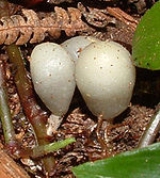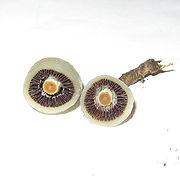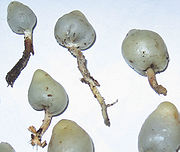
Weraroa novae-zelandiae
Encyclopedia
Psilocybe weraroa is a hallucinogenic pouch fungus of New Zealand
.
transferred it to Weraroa
in 1958.
Phylogenetic analysis by Moncalvo (2002) and Bridge et al. (2008)has demonstrated the close relationship between Weraroa novae-zelandiae and the hallucinogenic blue-staining group of Psilocybe, particularly Psilocybe subaeruginosa
. Phylogenetic analysis published by Borovička and colleages (2010) shows this species is very close to Psilocybe cyanescens
. Given this and the apparently distant relation with other species of Weraroa
Borovička et al. (2010) suggest renaming the species Psilocybe weraroa. The specific epithet weraroa refers to the former generic name. The binomial Psilocybe novae-zelandiae could not be used, as it had already been used in 1978 by Gastón Guzmán
and Egon Horak for another Psilocybe species.
Weraroa virescens is often mistaken for P. weraroa since they are both naturally pale bluish, however, unlike P. weraroa, W. virescens does not stain blue. The sepia
color of the gleba
also serves to separate P. weraroa from similar species in the genus Weraroa.
. It has also been found fruiting on rotted cabbage tree and is often associated with decaying fern fronds, native to the forests of New Zealand
, typically South of Wanganui
in the North Island. It is fairly abundant in the early winter and spring months in lowland mixed rain-forest near Wellington
. The pouch fungus has been found in winter in Central Hawkes Bay where they tend to be found around fallen pine cones - not in pine forests but in areas where pines are interspersed by other kinds of trees. They are also found on the south island. The mushroom is sometimes hard to see because its usually hidden under dried leaves. It is often eaten by slugs and sometimes hard to find specimens that haven't been nibbled on.
and psilocybin
are the chemical components considered to be responsible for its effects, as with other blue-staining fungi of the genus Psilocybe.


New Zealand
New Zealand is an island country in the south-western Pacific Ocean comprising two main landmasses and numerous smaller islands. The country is situated some east of Australia across the Tasman Sea, and roughly south of the Pacific island nations of New Caledonia, Fiji, and Tonga...
.
Taxonomy
The species was first described in the literature in 1924 by the New Zealand-based mycologist Gordon Heriott Cunningham, under the name Secotium novae-zelandiae. Rolf SingerRolf Singer
Rolf Singer was a German-born mycologist and one of the most important taxonomists of gilled mushrooms in the 20th century....
transferred it to Weraroa
Weraroa
Weraroa is a genus of mushrooms in the Strophariaceae family. The genus was initially described by mycologist Rolf Singer in 1958 to accommodate the single species Secotium novae-zelandiae reported by Gordon Herriott Cunningham in 1924...
in 1958.
Phylogenetic analysis by Moncalvo (2002) and Bridge et al. (2008)has demonstrated the close relationship between Weraroa novae-zelandiae and the hallucinogenic blue-staining group of Psilocybe, particularly Psilocybe subaeruginosa
Psilocybe subaeruginosa
Psilocybe subaeruginosa is a psychedelic mushroom of Australasia, which has psilocybin and psilocin as main active compounds.First reported in 1927, it is placed in the section Cyanescens, which includes Psilocybe cyanescens and Psilocybe maire....
. Phylogenetic analysis published by Borovička and colleages (2010) shows this species is very close to Psilocybe cyanescens
Psilocybe cyanescens
Psilocybe cyanescens is a species of potent psychedelic mushroom. The main compounds responsible for its psychedelic effects are psilocybin and psilocin. It belongs to the family Strophariaceae...
. Given this and the apparently distant relation with other species of Weraroa
Weraroa
Weraroa is a genus of mushrooms in the Strophariaceae family. The genus was initially described by mycologist Rolf Singer in 1958 to accommodate the single species Secotium novae-zelandiae reported by Gordon Herriott Cunningham in 1924...
Borovička et al. (2010) suggest renaming the species Psilocybe weraroa. The specific epithet weraroa refers to the former generic name. The binomial Psilocybe novae-zelandiae could not be used, as it had already been used in 1978 by Gastón Guzmán
Gastón Guzmán
Gastón Guzmán is a Mexican mycologist and anthropologist. He is considered the world's foremost authority on the genus Psilocybe.He was born in Xalapa, Veracruz, in 1932....
and Egon Horak for another Psilocybe species.
Description
- Peridium: (1)3– 5 cm tall, 1.5– 3 cm wide, irregularly roundish to ovate, elliptical or even depressed-globose, margin folded, light brown when young becoming pale blue-grey, often showing blue or blue-green stains with age, at first finely fibrillose becoming smooth, glabrous, slightly viscid, bruising blue when injured, slowly. Drying dingy brown.
- GlebaGlebaGleba is the fleshy spore-bearing inner mass of fungi such as the puffball or stinkhorn.The gleba is a solid mass of spores, generated within an enclosed area within the sporocarp. The continuous maturity of the sporogenous cells leave the spores behind as a powdery mass that can be easily blown away...
: Chocolate or sepia-brown, sparse, chambered, contorted gill-like structures. - Spores: 11–15(17) x 5–8 µm in size, smooth, sepiaSepia (color)Sepia is a dark brown-grey color, named after the rich brown pigment derived from the ink sac of the common cuttlefish Sepia.The word sepia is the Latinized form of the Greek σηπία, sēpía, cuttlefish.-Sepia in human culture:...
-coloured, elliptic-ovate or elliptical in shape, rounded at one end with a thin epispore. - StipeStipe (mycology)thumb|150px|right|Diagram of a [[basidiomycete]] stipe with an [[annulus |annulus]] and [[volva |volva]]In mycology a stipe refers to the stem or stalk-like feature supporting the cap of a mushroom. Like all tissues of the mushroom other than the hymenium, the stipe is composed of sterile hyphal...
: Up to 4 cm tall, 6 mm thick, equal, cartilaginous, whitish to blue-grey, yellowish-brown at the base, hollow, bruising blue when injured. - Taste: Bitter-sweet, earthy flavor, released upon chewing of the raw fruit, probably not a taste sought after for culinary purposes.
- Odor: Organic, similar to ferns, undertone of rubber.
- Microscopic features: Oval Spores
Weraroa virescens is often mistaken for P. weraroa since they are both naturally pale bluish, however, unlike P. weraroa, W. virescens does not stain blue. The sepia
Sepia (color)
Sepia is a dark brown-grey color, named after the rich brown pigment derived from the ink sac of the common cuttlefish Sepia.The word sepia is the Latinized form of the Greek σηπία, sēpía, cuttlefish.-Sepia in human culture:...
color of the gleba
Gleba
Gleba is the fleshy spore-bearing inner mass of fungi such as the puffball or stinkhorn.The gleba is a solid mass of spores, generated within an enclosed area within the sporocarp. The continuous maturity of the sporogenous cells leave the spores behind as a powdery mass that can be easily blown away...
also serves to separate P. weraroa from similar species in the genus Weraroa.
Habitat and distribution
Psilocybe weraroa is found growing solitary to gregarious on decaying wood buried in forest leaf litter, often on the rotting branches of Melicytus ramiflorusMelicytus ramiflorus
Melicytus ramiflorus is a small tree of the family Violaceae endemic to New Zealand.It grows up to 10 metres high with a trunk up to 60 cm in diameter, it has smooth, whitish bark and brittle twigs...
. It has also been found fruiting on rotted cabbage tree and is often associated with decaying fern fronds, native to the forests of New Zealand
New Zealand
New Zealand is an island country in the south-western Pacific Ocean comprising two main landmasses and numerous smaller islands. The country is situated some east of Australia across the Tasman Sea, and roughly south of the Pacific island nations of New Caledonia, Fiji, and Tonga...
, typically South of Wanganui
Wanganui
Whanganui , also spelled Wanganui, is an urban area and district on the west coast of the North Island of New Zealand. It is part of the Manawatu-Wanganui region....
in the North Island. It is fairly abundant in the early winter and spring months in lowland mixed rain-forest near Wellington
Wellington
Wellington is the capital city and third most populous urban area of New Zealand, although it is likely to have surpassed Christchurch due to the exodus following the Canterbury Earthquake. It is at the southwestern tip of the North Island, between Cook Strait and the Rimutaka Range...
. The pouch fungus has been found in winter in Central Hawkes Bay where they tend to be found around fallen pine cones - not in pine forests but in areas where pines are interspersed by other kinds of trees. They are also found on the south island. The mushroom is sometimes hard to see because its usually hidden under dried leaves. It is often eaten by slugs and sometimes hard to find specimens that haven't been nibbled on.
Psychoactivity
Psilocybe weraroa is psychoactive. PsilocinPsilocin
Psilocin , an aromatic compound, sometimes also spelled psilocine, psilocyn, or psilotsin, is a psychedelic mushroom alkaloid. It is found in most psychedelic mushrooms together with its phosphorylated counterpart psilocybin...
and psilocybin
Psilocybin
Psilocybin is a naturally occurring psychedelic prodrug, with mind-altering effects similar to those of LSD and mescaline, after it is converted to psilocin. The effects can include altered thinking processes, perceptual distortions, an altered sense of time, and spiritual experiences, as well as...
are the chemical components considered to be responsible for its effects, as with other blue-staining fungi of the genus Psilocybe.



